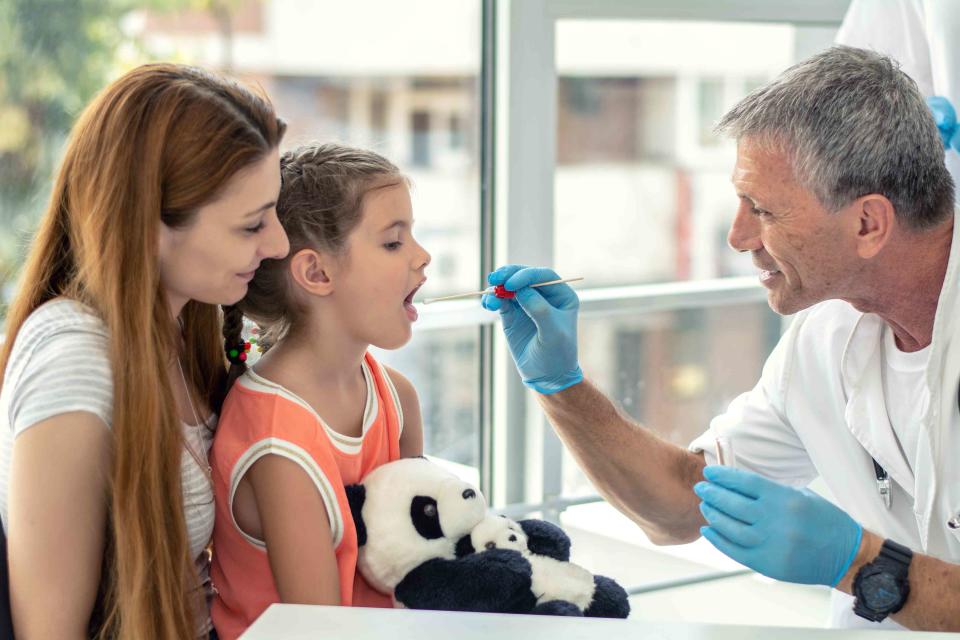15 Strep Throat Symptoms in Kids
Kids get sore throats for many reasons, like the common cold or allergies. But it could also be strep. Learn about strep throat causes, symptoms, and treatment.

Dardespot / Getty Images
Medically reviewed by Wendy L. Hunter, M.D.
It's common for a child (or an adult, for that matter) to complain about a sore throat. After all, dry air, sleeping near a fan, or even the common cold can cause a sore throat. But when that sore throat makes it difficult to swallow or, in some cases, talk, then you know something is amiss.
Strep throat is a common bacterial infection, and according to the Centers for Disease Control and Prevention (CDC), leads to more than 5 million medical visits in the U.S. every year, for all ages. Keep reading to learn more about strep throat symptoms in kids, causes, and treatment.
Related: Can Allergies Cause a Sore Throat?
What Is Strep Throat?
Strep throat is an infection of the throat and/or tonsils caused by a bacteria called group A Streptococcus (group A strep). It causes pain in the throat with swallowing—it can be severe—and may present with symptoms affecting the entire body.
Rashmi Jain, M.D., a concierge pediatrician in Irvine, California, and founder of Babies MD, says strep throat is a common illness in school-age kids between 5 and 15 years old; it's rare in kids under the age of 3. Up to 30% of kids with a sore throat have strep, says Dr. Jain.
It's important to treat strep throat. "In children, if strep throat is not treated quickly with antibiotics, they run the risk of long-term consequences affecting their heart, joints, kidneys, or nervous systems," says Dr. Jain.
What Are Strep Throat Symptoms in Kids?
The classic symptom of strep is a sore throat, but that's true of lots of illnesses, including colds and the flu. If your child has strep throat, you will likely also see some of the following:
Red spots on the roof of the mouth
Pain with swallowing
Red swollen tonsils
White streaks on tonsils
Tender swollen lymph nodes in the neck
Neck pain
Fever
Headache
Tummy ache
Nausea and/or vomiting
Loss of appetite
Muscle and/or joint pain
Rash
Fatigue
How To Tell the Difference Between Sore Throat and Strep in Kids?
"A sore throat can occur in the setting of allergies/post-nasal drip, irritation from vomiting, viral infection, or other bacterial infections," explains Nicole Aaronson, M.D., MBA, FACS, FAAP, of Children's Health of Delaware and clinical and associate professor of otolaryngology and pediatrics at Thomas Jefferson University Sidney Kimmel in Philadelphia. "Strep throat denotes infection with one specific bacterium."
The only true way to know if a child has strep throat is to have their throat swabbed by a doctor and tested for the bacterium. Since strep throat is contagious and typical among the school-age set, you might be clued into strep if your child shares the same symptoms as other kids at their school who have been diagnosed with it. If you suspect strep throat, call your child's health care provider immediately to have them tested.
Dr. Jain also points out that a sore throat associated with strep tends to happen abruptly, unlike a sore throat with a common cold or the flu. "The sore throat with a strep throat infection comes on all of a sudden," she says. "It is much more intense than the sore throat one would have with allergies or a common cold."
Related: What Is Strep A? Causes, Symptoms, and When to Worry
How Is Strep Spread and Is It Contagious?
Strep throat is very contagious. "Respiratory secretions transmit it, so it is easily transmitted by talking, sneezing, and coughing," says Dr. Aaronson. "The bacteria can also live on surfaces, so touching a contaminated surface and then touching one's eye, nose, mouth can also spread infection."
Strep is still contagious for 24 hours into a course of antibiotics, so it is wise to stay away from others while beginning antibiotics. It's also a good idea for your child to change their toothbrush after starting antibiotics.
How Is Strep Treated?
According to the CDC, kids diagnosed with strep throat require antibiotics to relieve symptoms, prevent the spread of strep, and reduce the risk for long-term consequences. Although they are not common, they can include rheumatic fever (affecting the heart, joints, brain, and skin) and post-streptococcal glomerulonephritis (a type of kidney disease).
But does every kid need antibiotics? In most cases, yes. "Strep throat in children requires antibiotics to expedite resolution of symptoms, prevent spread, and reduce the risk for long-term consequences," says Dr. Jain. "It is crucial to complete the entire 10-day course of antibiotics to prevent complications in other organ systems of the body."
When Should a Parent Worry?
When your child has a sore throat, it might be easy to jump to conclusions. But there are lots of illnesses that cause a sore throat that are not strep, says Dr. Jain. So, when do you need medical attention?
"Consider seeking treatment when sudden sore throat occurs accompanied by symptoms of fever, swollen tonsils, or swollen lymph nodes," says Dr. Aaronson. "Medical attention is also reasonable if a child stops eating or drinking or is showing symptoms of becoming dehydrated."
After starting antibiotics, a child should start feeling better within one to three days. They can return to school after 24 hours of antibiotic treatment. Call your child's provider if they are not feeling better after 48 hours of treatment.
The Bottom Line
If your child has a sudden sore throat and red spots to match, take them to see their health care provider right away to be screened for strep throat. They can prescribe antibiotics and give advice for relieving symptoms and helping your child go back to feeling like themselves in no time.
For more Parents news, make sure to sign up for our newsletter!
Read the original article on Parents.

